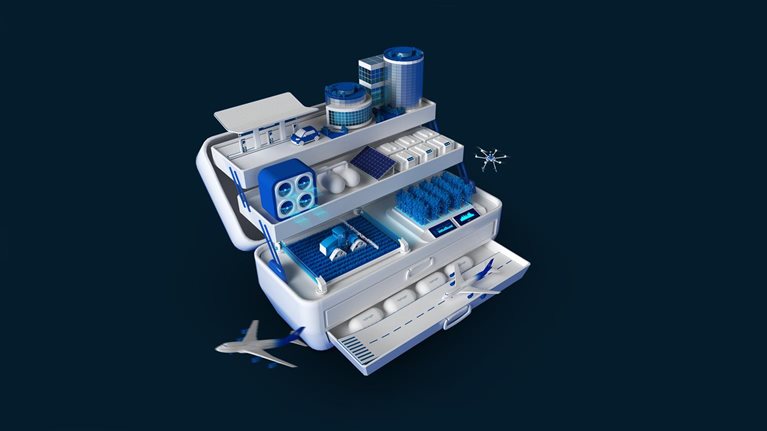Around the world, governments are recognizing the importance of clean hydrogen in building an energy system to reach net-zero carbon emissions. As of October 2021, 17 governments had published hydrogen strategies and more than 20 were in the process of developing strategies.1 The US Department of Energy (DOE) has declared clean hydrogen crucial to achieving President Biden’s goals of a 100 percent clean electrical grid by 2035 and net-zero carbon emissions by 2050.2
The current economics of clean-hydrogen production and distribution do not currently support large-scale adoption by customers to replace lower-cost, higher-carbon-intensity alternatives. Regional hydrogen hubs have the potential to accelerate the scaling of hydrogen through concerted development of demand, supply, and infrastructure. But policy interventions will be required to drive down costs and incentivize the adoption of clean hydrogen.
A Houston-led clean-hydrogen hub could have sizeable and lasting impact on the region. Based on the estimated potential, the economic, environmental, and social benefits in 2050 could be substantial, fundamentally shaping the long-term vision of the hydrogen hub (exhibit).

This vision rests on an assessment of the clean-hydrogen value chain, including both supply and demand and sample projects. Realizing the vision will require implementing a core set of enablers. Key findings across these topics are summarized below:
Supply
- Many factors give Texas significant advantages on the cost and capacity of hydrogen production, such as abundant renewable power generation and low-cost natural gas, existing hydrogen production capacity, favorable geological formations for storing hydrogen and CO2, and local demand drivers, as well as top-caliber academic research and industry-led innovation.
- Texas already benefits from access to renewables and natural gas, with Texas producing more wind-powered generation and natural gas than any other state.3
- Clean-hydrogen production costs in Texas are expected to improve from 2022 to 2050, with electrolysis-based hydrogen cost decreases attributable primarily to lower renewable costs and electrolyzer-system capital expenditures (capex), and natural-gas-based hydrogen cost decreases attributable to system efficiency gains and capex reductions.
- The estimated cost of producing natural-gas-based hydrogen with carbon capture and storage (CCS) in 2030 could meet the DOE’s goal of $1 per kilogram of clean hydrogen; however, electrolysis-based hydrogen is unlikely to achieve this target without government interventions in the form of research and development funding or direct incentives for hydrogen production and supporting technologies, such as renewables and CCS.
- Texas has natural advantages in developing cost-effective hydrogen transport and storage, given its extensive oil and gas and hydrogen pipelines, experience in hydrogen storage, salt caverns, and developed port infrastructure.
- The Gulf Coast is positioned to be the center of a clean-hydrogen US export hub, given the region’s ability to potentially compete with likely major exporters (for example, Australia, Chile, and Saudi Arabia) on the delivered cost of hydrogen by leveraging its cost advantages and significant port infrastructure. Several strategic considerations (for instance, security, reliability, and capacity) also provide advantages.
Demand
- While global clean-hydrogen demand is limited today, it is expected to grow 6 to 8 percent each year on average between 2030 and 2050. Hydrogen is expected to play a critical role in decarbonizing sectors such as industry, mobility, and power—potentially addressing 660 million tons (MT) of worldwide demand by 2050, according to the Hydrogen Council.4
- Demand for clean hydrogen in Texas could reach 21 MT by 2050, compared to current demand of 3.6 MT for conventionally produced hydrogen. The expected demand in 2050 comprises 11 MT for local demand and a surplus of 10 MT for export.
- Export of hydrogen and hydrogen-based fuels is the largest driver of the increase, contributing about 10 MT of hydrogen demand.
- Industrial applications are the second-largest driver, with feedstock and heating in sectors such as refining, petrochemicals, ammonia, iron and steel, and cement accounting for about 6 MT of hydrogen demand.
- Mobility is the third-largest driver, with ground transportation (trucks, light commercial vehicles, and buses) accounting for approximately 2.3 MT of hydrogen demand and marine and aviation accounting for about 1.5 MT of hydrogen and hydrogen-based fuel demand.
- Utility power generation is the fourth-largest driver, with energy storage and local-grid natural-gas blending accounting for approximately 1.6 MT of hydrogen demand.
Vision and strategic road map
- The proposed 2050 vision could have massive impact on climate, jobs, and the economy, including an estimated 220 MT of global CO2 abatement, $100 billion in economic value, and the creation of 180,000 jobs.
- With the right supportive policy frameworks, Texas could become the global leader in clean-hydrogen production, application, development, and exports with Houston at its core; the resulting thriving hydrogen community could push innovation and develop the necessary talent to conceive and deliver hydrogen projects.
- Realizing the 2050 vision requires a multiphase road map. Phase 1 (2022–25) should jumpstart a vibrant ecosystem while advocating for regulatory and policy incentives. Phase 2 (2025–30) should decarbonize existing applications while exploring new ones. In phase 3 (2030–35), the hub should seek to achieve the target of $1 per kilogram of clean hydrogen while further scaling local demand and export in phase 4 (2035–50).
- Texas could substantially improve social and environmental conditions for all communities, especially by focusing on environmental justice (EJ) for disadvantaged communities affected by industrial pollution. This is an opportunity to better serve those residents who might be disproportionally impacted by poor air quality and other environmental factors.
Sample projects
- As the clean-hydrogen ecosystem develops, a variety of projects addressing supply, demand, and infrastructure might spread across the state, concentrated in areas around Greater Houston, Corpus Christi and South Texas, Dallas and the Texas Triangle, Beaumont and East Texas, and West Texas.
- The hub structure would enable an integrated ecosystem, which balances supply, demand, and infrastructure needs. Achieving an end-to-end balance would require an orchestrated approach by participants across the clean-hydrogen value chain.
Cross-cutting enablers
- Government commitments, direct incentives, and regulatory frameworks are the major policy instruments for decreasing cost and increasing demand. In addition to federal policies, Texas should implement state-level policies to accelerate progress toward realizing the 2050 vision. This report provides an initial view on policy topics. More work is needed to flesh out the appropriate options.
- Scaling hydrogen will require developing infrastructure, including hydrogen transport and storage, fueling stations, CO2 transport and storage, water purification and transportation, electricity transmission, port infrastructure, and a mature supply chain for critical materials.
- The hub would benefit from a vibrant innovation ecosystem, including a research consortium that fosters collaboration across institutional lines, a joint-venture/start-up network that leverages existing assets and demand in the region, a testing facility to scale and commercialize new technologies, and local equipment manufacturing.
- Meeting the hub’s talent needs would require implementing equitable workforce development programs. Community colleges, institutions of higher education, and companies could all play key roles in training the workforce for the hydrogen economy.
Next steps
The next phase of this work will build on the findings presented in this report to develop a demand-centric road map for 2022–2030. More specifically, the next phase will identify the sectors that are ready to respond to net-zero-driven demand signals for clean hydrogen and projects that can meet demand via a network of supply, shared infrastructure, and storage. This phase will also explore hub-funding requirements, sector-specific legal and regulatory unlocks, and ways to build the right coalition for an integrated effort to develop the hydrogen hub. Collectively, these actions will create the blueprint for Houston to navigate the energy transition and continue thriving as the energy capital of the world.


